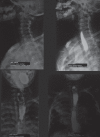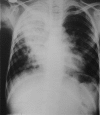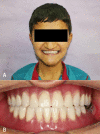Edentulous child with Allgrove syndrome: a rare case report
- PMID: 27895694
- PMCID: PMC5118506
- DOI: 10.3345/kjp.2016.59.11.456
Edentulous child with Allgrove syndrome: a rare case report
Abstract
Triple-A syndrome, also known as Allgrove syndrome, is a rare autosomal recessive disorder. The 3 features of this syndrome are achalasia, adrenal insufficiency, and alacrima. Achalasia could be the first manifestation of the triple-A syndrome; however, its etiology is unclear. Alacrima is generally asymptomatic but can be detected by obtaining patient history. Although adrenal insufficiency could have manifestations such as asthenia, it might be wrongly diagnosed as muscle fatigue. Vitamin D and calcium supplements are usually prescribed for the prevention of osteoporosis. Neurologic manifestations could be present in adults. In some individuals with this disorder, genetic examination indicates mutations in both alleles of the AAAS gene, which encodes a special 546-amino-acid protein designated ALADIN, and in chromosome 12q13. The genetic cause of the triple A syndrome in some patients who do not have an identified mutation is unknown. While very few such cases have been reported till date, one such case was presented to us as an edentulous child.
Keywords: Achalasia; Allgrove; Child; Syndrome.
Conflict of interest statement
No potential conflict of interest relevant to this article was reported.
Figures





References
-
- Li Y, Fallon SC, Helmrath MA, Gilger M, Brandt ML. Surgical treatment of infantile achalasia: a case report and literature review. Pediatr Surg Int. 2014;30:677–679. - PubMed
-
- Williams VA, Peters JH. Achalasia of the esophagus: a surgical disease. J Am Coll Surg. 2009;208:151–162. - PubMed
-
- Sharp NE, St Peter SD. Treatment of idiopathic achalasia in the pediatric population: a systematic review. Eur J Pediatr Surg. 2016;26:143–149. - PubMed
-
- Vallet AE, Verschueren A, Petiot P, Vandenberghe N, Nicolino M, Roman S, et al. Neurological features in adult Triple-A (Allgrove) syndrome. J Neurol. 2012;259:39–46. - PubMed
-
- Francis DL, Katzka DA. Achalasia: update on the disease and its treatment. Gastroenterology. 2010;139:369–374. - PubMed
LinkOut - more resources
Full Text Sources
Other Literature Sources

